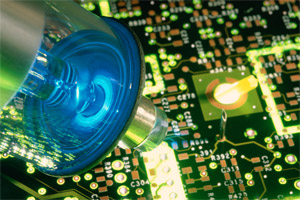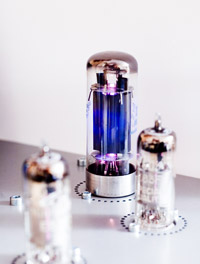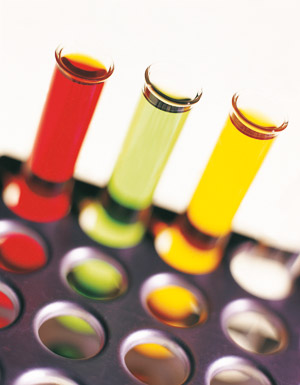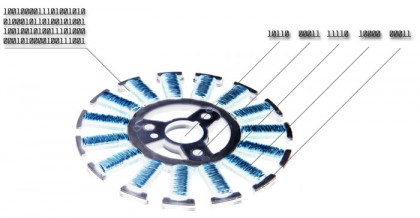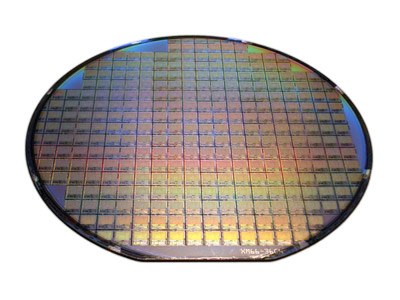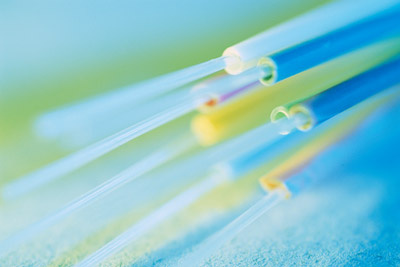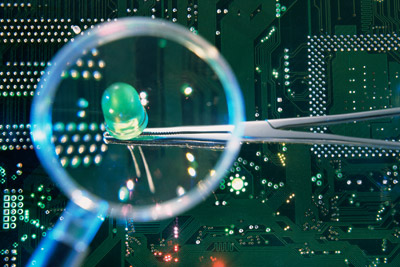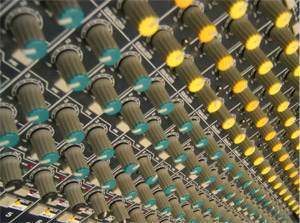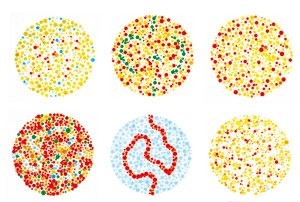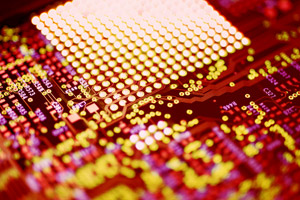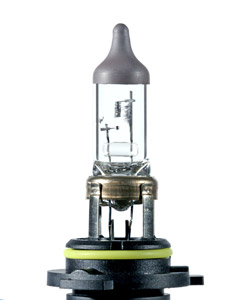History of Science at the Faculty
The subject of the first research on faculty research interests defined Dean Tereshchenko AI – Student academic Slutsky OO He studied the interaction of electrons with the fields in the microwave magnetron cutting. Increase the power output of the generator failed nets by introducing a space cathode – anode. Then multichamber magnetron was investigated in order to find ways to control the electronic frequency generation. In one embodiment, the magnetron frequency control generation was carried out by introducing the electron beam in the region between the bonds.
The department under the leadership vacuum electronics Zinchenko MS together with UTPI developed three-electrode electron gun, which used longitudinal beam compression. Under the leadership of VP Shestopalova began the study of slowing down, which increased resistance connection (Bulgakov BM, Ślusarski VA). By this time include the results for the study of complex waveguide cross-sectional shape, providing a broad band frequency (gray VM), and develop a method for measuring the dielectric constant material using surface waves allowed to conduct research electrical properties of dielectrics in a wide band (Yatsuk KP). The next step of research at the Faculty was the beginning of the development of the field of millimeter and submillimeter waves.
Under the guidance of prof. Valytova RO started the development of instrumentation in this frequency range. For the first time in the USSR was constructed measuring system, which includes wavemeters, power meter, frequency heterodyne and others. On the other hand, was transferred from the Department of Physics Department of Technical Physics (Head of Department Assoc. Dr. Weaver) began the study of the structure and physical properties of the complex dielectric using radio-resonance methods and relaxation techniques that were developed. Combining physics and technology has given excellent results and led to a development of quantum electronics in the current Department of Quantum Radiophysics. Subsequently it in a separate department of biophysics.
Over the entire period of the faculty should provide several groups united by close scientific interests. This group engaged: 1) issues electrodynamics – diffraction, scattering, and the spread of radiation of radio waves; 2) issues related to the study of the structure of matter and its interaction with the electromagnetic field; 3) wave propagation in space, including astronomy.
Widely known in the USSR and abroad were the work of Professor VP Shestopalova for the study of radiation and diffraction of electromagnetic waves by the method of Riemann-Hilbert boundary value problems of electrodynamics solutions. An analysis of the scattering fields of electron beams periodic inhomogeneities was proposed and a new generator of diffraction radiation (DRO) with unique performance characteristics. Development of methods napivzvorotu operator Helmholtz equation allowed to conduct rigorous calculation of scattering in the fields of public and private electrodynamic systems arbitrarily complex configuration. Currently, the Department of Theoretical Radiophysics developed following topics. Electrodynamics of periodic structures with resonant diffraction characteristics (head prof. Kazan VB), the fundamental theoretical and experimental studies of the processes of amplification and generation of continuous and pulse MM and SMM ranges in resonant electronic devices and equipment with a long O-type interaction (headed by Prof. . Tretyakov OA); Fundamental investigations of diffraction and propagation of wave formations in heterogeneous anisotropic random media, including media with inclusions (head prof. OATretyakov); use of UWB signals to create a new measurement technologies and devices to control substances (head prof. Kolchigin MM)
The department has the following Microwave Physics research. The first of these electronic components developed standard receiving-transmitting paths based on both volume hvylovodni transmission lines and new – strip, slotted, coplanar such that different high technology manufacturing, low weight and dimensions. Is constructed in millimeter wave radiometer area studies transmission lines at low temperatures, developed devices for microwave dielectric drying at high temperatures (head prof. VM gray). Under the guidance of prof. Poharskoho SA develop effective methods for calculating transmission lines millimeter range. Second – study gyrotropic waveguide resonators with inclusions studied physics resonances in waveguide ramifications, brought a great contribution to the theory hvylovodni-dielectric resonators, developed methods for measuring parameters of anisotropic dielectrics microwave (supervisor Assoc. Korobkyn VA). The third – studied law excitation, propagation and radial wave radiation in the microwave range based on electrodynamic systems with anisotropic outside. The developed analysis techniques allowed to carry out calculations of polarization antennas governed by pathogens kolopolyaryzovannyh waves in waveguides, compact broadband passive microwave devices (head prof. Yatsuk KP). The new issues – ray research methods, complex rays and beams in problems of distribution, diffraction and scattering of waves, and the improvement of methods of nondestructive testing using automated gauges – engaged team led by head. Department Assoc. Zvyahyntseva OO The scientific team led by prof. Shmatko AA developed the theory of nonlinear processes of interaction electron beams with high-frequency fields in the generation, increasing radiation waves in systems with extended slow-wave structures – LBV, fishing, DRO in stationary and non-stationary modes for regular, noise and stochastic fluctuations.
At the Department of Applied Electrodynamics developed the theory of microwave antennas in a wide variety of them, including dipole, slot, horn, mirrors and items tract waveguide feeder. Studies are beginning Assoc. Shubarynu J., who proposed methods of analysis and path construction aperture and waveguide-slot antennas with controlled polarization. Further research at the department were in these areas. In one of them studied Waveguide and mirrored circular polarization antenna. With the use of rigorous methods of analysis using integral equations and Wiener-Hopf method were obtained new results on research fields near the antenna and method of controlling the polarization fields radiated. Developed and implemented multi bahatohvylovi and systems with controlled polarization, designed a number of elements paths (head prof. Gorobets MM) waveguide feeders. The second direction was the decision of the internal waveguide-slot assignments involving excitation waveguide theory, developed Kisunko GV Feld and YA.N. and apparatus tensor Green’s functions. Were the results obtained by the excitation of the waveguide slots nekoordynatnymy outside and aerial complex configuration (head prof. Yatsuk LP). Using Galerkin analysis of distribution fields in the narrow slits in the waveguide allowed to go to study antennas based on electrically long gaps and get the original results (Assoc. Liashchenko VA, Assoc. Katrich VA). Under the guidance of prof. Khizhniak NO based on integral equations of electrodynamics were developed methods for solving problems asympotychni scattering dipole and slot inhomogeneities in the waveguide. Of particular interest are the results obtained by holography.
At the Department of Quantum Radiophysics researched and created new generators of millimeter and submillimeter waves – lasers of different types. To implement the devices in practice had to make calculations, research and & lt; & lt; cold & gt; & gt; of them – resonators open. So there was a group that studies the electrodynamics of open resonators and develops special instrumentation for their experimental studies. Through the efforts of a large team led by professors Dyubko SF Candle and VA were established for the first time in the USSR lasers with optical pumping, with more than 1,000 open new lines of generation and offered more than 30 new active media. In addition, for the first time in the Soviet Union created submilimetrovi discharge lasers. The need to study the characteristics of radiation generators newly developed, led to the series of works on the development of a large number of measurement methods and designing instrumentation. Thus, for the first time in the USSR were designed and created by laser energy meters from tonkodrotovyh bolometers (head prof. Kuzmichev VM). For the first time in the USSR created interferometry for high-temperature plasma diagnostics in thermonuclear plants based on gas discharge and optically nakachuvanyh submillimeter lasers (head prof. Switch VA). For the first time in the USSR are designed and created by ponderomotive and gradient power meters and laser energy (head prof. Kokodiy MG) developed equipment widely implemented in leading institutes of the Soviet Union in the field of research isotopes, nuclear fusion reactions semiconductor materials. At this time, the department carried out intensive research in molecular spectroscopy of atoms in ridberhovskyh states, creating small generators submillimeter range research environment created using radar-based CO2 laser action on research submillimeter radiation on living organisms.Under the guidance of prof. Baskakov A.I. studied the spectra of high section of molecules in isolated or interacting vibrational states. Under the guidance of prof. Maslov V.A. deals with the formation and selection of transverse modes in laser cavities.
At the Department of Quantum Radiophysics researched and created new generators of millimeter and submillimeter waves – lasers of different types. To implement the devices in practice had to make calculations, research and & lt; & lt; cold & gt; & gt; of them – resonators open. So there was a group that studies the electrodynamics of open resonators and develops special instrumentation for their experimental studies. Through the efforts of a large team led by professors Dyubko SF Candle and VA were established for the first time in the USSR lasers with optical pumping, with more than 1,000 open new lines of generation and offered more than 30 new active media. In addition, for the first time in the Soviet Union created submilimetrovi discharge lasers. The need to study the characteristics of radiation generators newly developed, led to the series of works on the development of a large number of measurement methods and designing instrumentation. Thus, for the first time in the USSR were designed and created by laser energy meters from tonkodrotovyh bolometers (head prof. Kuzmichev VM). For the first time in the USSR created interferometry for high-temperature plasma diagnostics in thermonuclear plants based on gas discharge and optically nakachuvanyh submillimeter lasers (head prof. Switch VA). For the first time in the USSR are designed and created by ponderomotive and gradient power meters and laser energy (head prof. Kokodiy MG) developed equipment widely implemented in leading institutes of the Soviet Union in the field of research isotopes, nuclear fusion reactions semiconductor materials. At this time, the department carried out intensive research in molecular spectroscopy of atoms in ridberhovskyh states, creating small generators submillimeter range research environment created using radar-based CO2 laser action on research submillimeter radiation on living organisms.
Scientific direction of Department of Space Radio Physics based professor Mysyuroy VA – study of fundamental physical processes in near-Earth space radiozonduvannya remote methods. The main scientific problems: study ionospheric parameters by registering signals satellites and terrestrial transmitters, the study of natural and artificial perturbations in near-Earth space, and the effects of perturbations on the characteristics of radio propagation and radio systems for various purposes, research on the action of powerful radio wave ionospheric plasma and environmental consequences of human action on the ionosphere. To perform the problems created by a number of fixed and mobile technical means. This – Radiophysics Observatory (RSP) in the Kharkiv region, which is the only center in Ukraine terrestrial radio physical research near-Earth space, and placed on vehicles radio research centers. For the first time in the USSR by the department conducted a cycle of measurement of ionospheric plasma and эkzosfernoyi incoherent scatter obtained vertical profiles of horizontal gradients and other characteristics of the plasma. Now the department under the direction of Head of Department Associate Professor AF Tarnovo Professor LF and Montenegro doing a great amount of work within the scientific and technical cooperation with leading scientific institutions as near and far abroad, participates in the research programs of the National Space Agency of Ukraine and the Antarctic Centre.
Department of Biological and Medical Physics as part of Radiophysics known radio-chairs, department of biophysics at the Department of Quantum Radio Physics and Department of Molecular and Applied Biophysics. Despite the name changes and changes zaviduvachok department – heads directions (associate Dr. Weaver, KM Kononenko, the degree of LD, professor BI Verkin, good YP, Lemeshko VV, Maleyev VJ, squab VV), major scientific research department has always been a radio physical methods of structure of matter animate and inanimate nature. Over the years the department has solved these problems. This – radiation biophysics of molecular crystals, biopolymers and biological tissues, research methods Biosystems dielectric spectroscopy study physics interactions of metal ions and ligands with low DNA study of the energy spectrum of biological macromolecules in a wide frequency range. There is a line of functional membrane biophysics and aging. Developing research physics interaction of DNA with drugs, using radio physical methods and the methods of quantum chemistry investigated the physical properties of nucleic acids. Recently investigated the impact of external factors (low temperature and ionizing microwave radiation) on the physical processes in biological systems. Last direction – development of new methods of physical medicine based on system analysis and construction of mathematical computer models and laboratory-specific physical processes for medicine. You can highlight key milestones faculty.
Main scientific achievements of faculty
Prepared and issued more than 6,000 young professionals, including 700 on the evening education. Among the graduates: Doctors – 120; candidates – 600; State Laureate – 39; rectors of higher educational institutions – 3; academics – 7; corresponding members – 7; directors of research institutes – 4; Directors plants – 3; Heroes of Socialist Labor – 1; Generals – 2; deputy ministers – 2; received more than 300 patents for inventions; – Published over 100 books; published more than 200 textbooks; held over 10 international conferences; published annually more than 200 scientific articles, 60% in foreign journals. For the Department of Quantum Radiophysics, instrumentation developed in the millimeter and submillimeter wavelength range (wavemeters, power meters, frequency heterodyne), studies of open resonators one of the main elements of lasers; created submilimetrovi discharge lasers; created submilimetrovi lasers with optical pumping, with more than 1,000 new lines first generation in the world, offered for the first time in about 50 new active media for lasers submillimeter range; designed and created laser energy meters based on thin-film bolometers; interferometers designed for high-temperature plasma diagnostics in thermonuclear plants based on gas discharge and optically nakachuvanyh submillimeter lasers; created ponderomotive and gradient power meters and laser energy; high resolution spectroscopy of atoms and molecules.
For the Department of Applied Electrodynamics: in antenna technology, developed unique designs antennas for aerospace aircraft; completed the general theory of aperture antennas with circular and elliptical polarization; Methods developed problem solving scattering and diffraction of electromagnetic waves on the slot and dipole-gap inhomogeneities in waveguides, including magnetodielectrics completed. For the Department of Space Radio Physics: in space research: the study of ionospheric parameters and characteristics of the radio wave signal is recorded by satellites and reliable radio transmitters, radio communication prediction parameters; Space research of natural and artificial perturbations in near-Earth space as closely, and the suffocation of the major sources of perturbations different radio physical methods; study of the effect of perturbations on the characteristics of radio propagation and radio systems for various applications; development of new diagnostic methods and perturbation mechanism of transmission over long distances; Interaction of powerful radio waves in the ionosphere plasma to develop methods for diagnosis of parameters; study radiopereshkodovoyi situation; study of the environmental consequences of human action on the ionosphere; creation and development of technology (both stationary and mobile) for complex radio physical research near-Earth space, its diagnosis and control.
For the Department of semiconductor and vacuum electronics, in semiconductors: first received microwave power generation in continuous operation in trohsantymetrovomu range at a frequency of 10 GHz for CaAs – diodes with intervalley transfer of electrons; first in the Soviet Union was obtained in generation CaAs – diodes in the range of 8, 4, 3, 2 mm up to 220 GHz with high levels of microwave power output. Developed by: diodes MPЭ and generators on the basis of SM and MM wavelengths (10..200 GHz) operating in continuous mode with parameters at the world’s best; high-performance microwave generators noise cm and mm-wave length (10..90 GHz) based on diode with cathode static domain analogues that have, in Ukraine and abroad; highly sensitive indicators of microwave radiation and infrared radiation; highly mahnitodiodni structure; methods and instruments for non-destructive testing of the gas filling the lamp pumping. For the Department of Theoretical Radiophysics, created a completely new Generator – Generator diffraction radiation with unique spectral characteristics established electrodynamic model of this class of generators, their theory generalizes together with staff IRЭ Academy of Sciences of Ukraine; was first proposed a new principle of protection of antennas and developed a system of high-Radar antenna shelters created electrodynamic theory and design technique made layouts and field tested; established method of reducing the reflection of radar defense technology, the technique and mobile devices characterize reflection.
For the Department of Physics microwave Designed elements and microwave devices, by patents; devices that are designed joined the radiometric systems, systems of radio ON, a non-standard device for high accuracy measurement and control parameters of anisotropic and gyrotropic materials; high power microwave devices includes a special component of radar systems and phased array antenna systems. The developed nonlinear theory of hybrid electronic devices mm range. For the Department of Biological and Medical Physics in biophysical research, developed systems for radiospektroskopichnyh studies of biological systems, microwave dyэlektrometrы, pulsed NMR spektroskopyy, ЭPR-spectroscope small-angle light scattering; installed and equipped with a unique gamma setting; Methods dielectric measuring blood (DVHK) to diagnose the state of the blood coagulation system in clinical practice. When faculty issued a scientific journal: Journal Harkovskoho National University VN Karazin. Radio Physics and Electronics. Here you can get detailed information.

